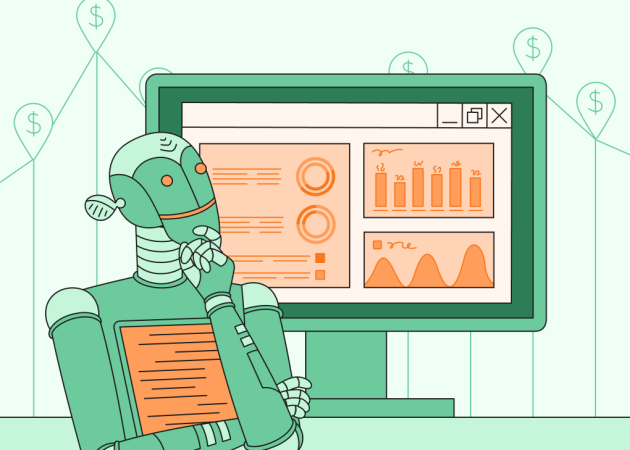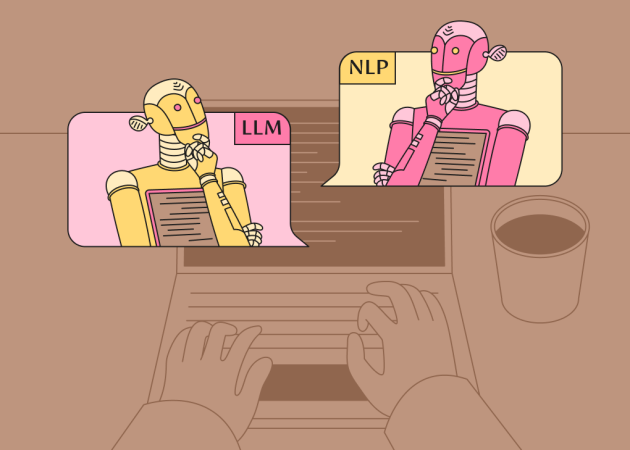
5 Practical Ways to Reduce AI Development Cost Without Sacrificing Results
Contents
Contents
AI can create significant value for businesses, but getting to that value can be expensive. Expenses can add up fast if there’s no clear plan in place. Many companies dive into projects only to find that training models from scratch, scaling cloud resources, and fixing inefficiencies push the AI development cost much higher than expected. The upside is that there are practical ways to keep budgets in check without cutting corners on quality or slowing down innovation.
Whether you consider building an in-house team or hiring dedicated AI developers, the right decisions made early can significantly impact your ROI. This article explores five smart ways to reduce AI costs, methods that balance efficiency and long-term value, giving you a roadmap to deliver results faster and more sustainably.
Reducing AI Cost with Open-Source Tools and Pre-Trained Models
Using open-source frameworks and pre-trained models is a good starting point for optimizing AI-related expenses. Mature platforms like TensorFlow, PyTorch, and Hugging Face provide reliable foundations that can accelerate development and reduce engineering hours, while helping companies better understand how much is AI worth in relation to the effort invested.
The advantage of using pre-trained models is that they allow teams to build AI systems on top of models that already understand core tasks in language, vision, or prediction, rather than starting from scratch Fine-tuning these models with domain-specific data helps companies use fewer resources, reduce computing costs, and accelerate time to market. For example, applying a pre-trained natural language model to customer service automation means you only need to customize it with your company’s vocabulary and workflows.
However, cost savings come with tradeoffs that businesses should carefully evaluate. Understanding what actually drives AI budget up is critical here:
- Licensing restrictions – Some open-source tools are free for research but require commercial licensing.
- Support and maintenance – Community-driven tools may lack formal support, leaving upkeep to your team.
- Hidden costs of fine-tuning – Adapting and scaling models for production can still involve compute and infrastructure expenses.
- Compliance and risk – Security, data privacy, and auditability need to be validated before deployment.
Leveraging open-source and pre-trained solutions reduces upfront investment and accelerates results, but companies should balance these benefits with long-term needs. If your project demands highly specialized features, a more customized build may ultimately drive stronger returns. Used strategically, these resources can strike the right balance between affordability, speed, and reliability in AI development.

Outsourcing or Partnering with Specialized AI Teams to Lower the Cost of AI
Another way to reduce the AI software price is by working with external specialists. When you hire AI teams and technology partners from outside your company, they bring expertise that your in-house staff might not have. This means you can skip steep learning curves and avoid expensive trial and error. Instead of spending months teaching your own developers advanced machine learning techniques, you can hire teams that already have proven methods, frameworks, and knowledge of the field. This accelerates delivery and helps contain both direct costs and opportunity costs.
Partners with specialized or niche expertise can also optimize resource use. They know how to handle data preparation, model selection, and deployment pipelines, cutting down on rework or inefficiencies. With that expertise on board, projects move faster to delivery and market. For example, companies exploring outsourcing in Vietnam often highlight the availability of skilled talent at competitive rates, making it a cost-effective option for AI projects without compromising quality.
Choosing the right partner is therefore critical for artificial intelligence cost estimation. Look for providers with transparent processes, proven experience in your industry, and a track record of successful AI deployments. Clear contracts, well-defined KPIs, and ongoing communication channels help align efforts and reduce misunderstandings.
Using MLOps Automation and CI/CD Pipelines to Optimize AI Pricing Software Development
Building an AI model is only half the challenge, but keeping it reliable, scalable, and cost-effective over time is where many projects overspend. That’s where MLOps (machine learning operations) and CI/CD pipelines (continuous integration and continuous delivery) come in. MLOps is not just a practice, it’s a fast-growing industry in its own right. The global MLOps market was estimated at around $2.2 billion in 2024 and is projected to grow at more than 40% CAGR in the coming years.
MLOps streamlines the entire lifecycle of a model, from data preparation to monitoring performance in production. When performance changes, automation takes care of versioning, scaling, and rollbacks. CI/CD pipelines test, validate, and release updates automatically, which saves engineering time, lowers costs, speeds up releases, and reduces downtime.
For example, a retail company running recommendation models may need to refresh predictions daily. With MLOps automation, data pipelines update and retrain models automatically, cutting recurring maintenance work by up to 40%. Companies relying on machine learning services can gain even more from this automation, since providers often integrate MLOps practices directly into their delivery.
By embedding MLOps and CI/CD, you don’t simply trim AI pricing, you build resilience into your AI systems. The upfront investment in automation pays back quickly through lower operating expenses and stronger ROI.
Optimizing Data Usage, Storage, and Cloud Resources
Data powers AI, but it’s also one of the largest factors in the costs of implementing AI. Collecting, cleaning, storing, and moving large datasets requires significant compute and infrastructure. Without a deliberate strategy, these expenses can spiral and even outweigh the business value AI models generate. To prevent this, you need a disciplined approach to how to handle data and manage cloud resources throughout the AI lifecycle.
Streamline Data Pipelines
An optimized data pipeline is one of the simplest ways to keep costs under control. Every unnecessary step in data ingestion, cleaning, or transformation adds processing time and compute expenses. By designing pipelines that only prepare and move the most relevant data, companies reduce the volume of information that models need to process.
Automation plays a crucial role at this stage. Tools for data cleaning, labeling, and validation cut down on manual effort and lower the risk of errors that may force retraining later. Establishing governance policies is equally important. Teams should regularly review which datasets still hold value and archive or discard those that no longer align with business goals. This avoids the trap of endlessly storing and reprocessing “just in case” data.
Key actions to streamline pipelines include:
- Reducing redundant steps – eliminating duplicate or unnecessary operations.
- Automating routine tasks – using data cleaning, labeling, and validation tools to reduce manual input.
- Focusing on relevant data – working with datasets directly tied to business outcomes.
- Applying governance policies – reviewing datasets regularly and excluding those that no longer add value.
- Archiving strategically – shifting low-priority data to cheaper storage or removing it entirely.
Make Smarter Storage Decisions
Many companies find a tiered approach more cost-effective: datasets that support active model training remain on fast-access systems, while older or less frequently used data is moved to cheaper archival storage.
You can also leverage techniques like compression and deduplication to further reduce storage requirements without compromising data quality. In this way, it’s possible to maintain the integrity of data assets while keeping infrastructure bills in check. Aligning storage policies with business priorities and focusing on datasets that truly drive value helps companies optimize their budgets.
Manage Cloud Resources Proactively
Cloud resources are another major driver of AI costs, and without oversight, charges for compute time, storage, and data transfer can escalate quickly. Proactive management starts with right-sizing infrastructure: provisioning the exact resources needed rather than paying for unused capacity.
Flexible features and monitoring practices can make a significant difference:
- Using spot instances – taking advantage of discounted, short-term compute capacity where flexibility allows.
- Enabling autoscaling clusters – automatically scaling resources up or down depending on demand.
- Scheduling workloads – preventing systems from running idle by aligning resource use with peak activity hours.
- Continuous usage monitoring – real-time consumption tracking to detect and shut down underutilized resources.
To manage costs effectively, treat the cloud as a dynamic environment that adapts to changing needs, not as a fixed asset that quietly accumulates expenses.

Adopting Agile Methodologies for Cost-Efficient AI Projects
Agile approaches aren’t just for software development, they also bring measurable benefits to AI projects. For companies asking how much is AI really adding in value compared to its cost, agile methods provide a clear answer by focusing on incremental delivery, feedback loops, and prioritization. These practices reduce wasted effort and help teams adapt quickly to change.
Incremental Delivery Reduces Risk
Agile breaks work into smaller and testable increments. Each release delivers partial functionality that can be validated early. This prevents expensive rework and lowers the risk of building features that don’t serve business goals.
Feedback Loops Drive Continuous Improvement
Agile emphasizes short cycles with regular stakeholder feedback. In AI projects, this means models are evaluated often, with input from both technical experts and business users. Frequent reviews highlight issues sooner, whether it’s model accuracy, bias, or usability so adjustments can be made before problems grow costly.
Prioritization Keeps Costs in Check
Not all features or experiments carry equal business value. Agile frameworks encourage teams to prioritize tasks that deliver the highest return on investment. For AI, this might mean focusing on the model’s most critical use cases first rather than spending resources on nice-to-have capabilities.
Avoiding Common Pitfalls and Measuring Success in AI Cost Reduction
In order to reduce the cost of artificial intelligence, you need to recognize and avoid traps that inflate budgets and delay delivery. Here’s a list of top areas that can quickly erode savings:
- Underestimating dataset costs – Collecting large datasets, labeling them for supervised learning, cleaning inconsistencies, and keeping them up to date often consumes more time and budget than expected. Teams that overlook this step risk budget overruns before the model is even trained.
- Over-engineering solutions – It’s tempting to build complex architectures with the latest frameworks, but complexity adds cost. Overly sophisticated systems may require more compute, specialized talent, and longer development cycles than necessary. Often, a simpler model or pipeline is enough at a fraction of the expense.
- Lack of stakeholder alignment – When business and technical teams aren’t on the same page, projects drift toward features that don’t serve core goals. This misalignment wastes development hours on low-value work and makes it harder to measure ROI.
- Ignoring compliance and security – Data privacy, governance, and regulatory requirements have to be incorporated from the start. If they’re overlooked, organizations may face fines, reputational damage, or the need for costly retrofits to bring systems into compliance.
- Poor resource planning – Cloud services make it easy to scale and overspend at the same time. Over-provisioned compute power, idle storage, or inefficient data transfers silently add up. Without proactive resource planning and monitoring, you may pay far more than necessary for infrastructure.
To measure whether cost-reduction strategies are working, you should monitor both financial and operational indicators:
- Time to delivery – how quickly new models or features move from design to production.
- Cost per model iteration – the average spend on training and testing cycles.
- Compute and storage costs – usage-based expenses from cloud providers.
- Cloud spend efficiency – tracking savings from right-sizing, spot instances, or autoscaling.
Smarter Choices for Sustainable AI Development
Cutting the cost of AI software doesn’t mean cutting corners, it means making smarter choices that last. When you build with cost efficiency in mind, you give your team room to innovate faster, adapt to changing markets, and create AI solutions that bring long-term value without draining your budget.
At Beetroot, we help you to strike this balance. As a trusted partner, we bring the technical expertise and practical know-how to make AI projects both cost-conscious and future-ready. If this sounds like the approach you’re looking for, let’s talk about how we can make it work for your team.
FAQs
How much does AI cost to develop in 2025?
The cost of AI development in 2025 varies widely depending on your project’s scope, data needs, and infrastructure choices. A small proof of concept or demo might start around $3K–$10K, while an MVP typically ranges from $30K–$75K+. Building a full-scale product can cost $75K–$200K+, and developing a robust AI platform may reach $200K–$500K+, especially when complex integrations and compliance come into play. If you’d like a more accurate estimate for your specific case, get in touch and we’ll help you outline the technical scope and costs that fit your goals.
How can outsourcing help reduce the cost of AI projects without losing quality?
Outsourcing to specialized AI teams allows you to bypass steep learning curves and avoid common mistakes. Experienced partners bring proven methods, frameworks, and domain expertise, which accelerates development and reduces rework. To maintain quality, it’s important to choose partners with transparent processes, relevant case studies, and clear communication practices.
Are open-source AI tools reliable for enterprise-level projects and cost savings?
Yes, mature open-source frameworks like TensorFlow, PyTorch, and Hugging Face are widely used in enterprise environments. They can reduce cost of AI development by eliminating licensing fees and speeding up prototyping. However, the tradeoffs include ensuring license compliance, providing internal support or managed services, and allocating resources for tuning and integration. With the right governance, open-source tools are both reliable and cost-effective.
What role does cloud optimization play in lowering AI cost and speeding up delivery?
Cloud services are essential for scaling AI, but they’re also a major cost driver if unmanaged. Optimizing cloud use, through right-sizing infrastructure, adopting spot instances, enabling autoscaling, and shutting down idle resources directly lowers expenses. At the same time, efficient cloud pipelines accelerate delivery by reducing delays in training, testing, and deployment. Done well, cloud optimization helps teams deliver value faster while keeping budgets lean.
Subscribe to blog updates
Get the best new articles in your inbox. Get the lastest content first.
Recent articles from our magazine
Contact Us
Find out how we can help extend your tech team for sustainable growth.







